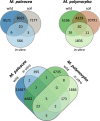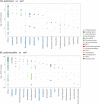Marchantia liverworts as a proxy to plants' basal microbiomes
- PMID: 30140076
- PMCID: PMC6107579
- DOI: 10.1038/s41598-018-31168-0
Marchantia liverworts as a proxy to plants' basal microbiomes
Abstract
Microbiomes influence plant establishment, development, nutrient acquisition, pathogen defense, and health. Plant microbiomes are shaped by interactions between the microbes and a selection process of host plants that distinguishes between pathogens, commensals, symbionts and transient bacteria. In this work, we explore the microbiomes through massive sequencing of the 16S rRNA genes of microbiomes two Marchantia species of liverworts. We compared microbiomes from M. polymorpha and M. paleacea plants collected in the wild relative to their soils substrates and from plants grown in vitro that were established from gemmae obtained from the same populations of wild plants. Our experimental setup allowed identification of microbes found in both native and in vitro Marchantia species. The main OTUs (97% identity) in Marchantia microbiomes were assigned to the following genera: Methylobacterium, Rhizobium, Paenibacillus, Lysobacter, Pirellula, Steroidobacter, and Bryobacter. The assigned genera correspond to bacteria capable of plant-growth promotion, complex exudate degradation, nitrogen fixation, methylotrophs, and disease-suppressive bacteria, all hosted in the relatively simple anatomy of the plant. Based on their long evolutionary history Marchantia is a promising model to study not only long-term relationships between plants and their microbes but also the transgenerational contribution of microbiomes to plant development and their response to environmental changes.
Conflict of interest statement
The authors declare no competing interests.
Figures





References
-
- Strullu-Derrien, C., Selosse, M. A., Kenrick, P. & Martin, F. M. The origin and evolution of mycorrhizal symbioses: From palaeomycology to phylogenomics. New Phytologist, 10.1111/nph.15076 (2018). - PubMed
-
- Knack JJ, et al. Microbiomes of Streptophyte Algae and Bryophytes Suggest That a Functional Suite of Microbiota Fostered Plant Colonization of Land. Int. J. Plant Sci. 2015;176:405–420. doi: 10.1086/681161. - DOI
Publication types
MeSH terms
Substances
Associated data
Grants and funding
- 237387/Consejo Nacional de Ciencia y Tecnología (National Council of Science and Technology, Mexico)/International
- TA200117/Dirección General de Asuntos del Personal Académico, Universidad Nacional Autónoma de México (Dirección General Asuntos del Personal Académico, Universidad Nacional Autónoma de México)/International
LinkOut - more resources
Full Text Sources
Other Literature Sources

